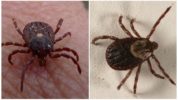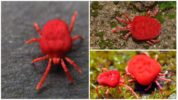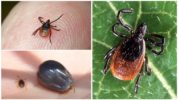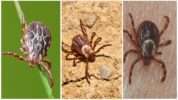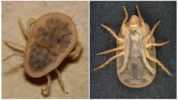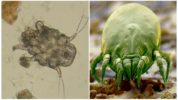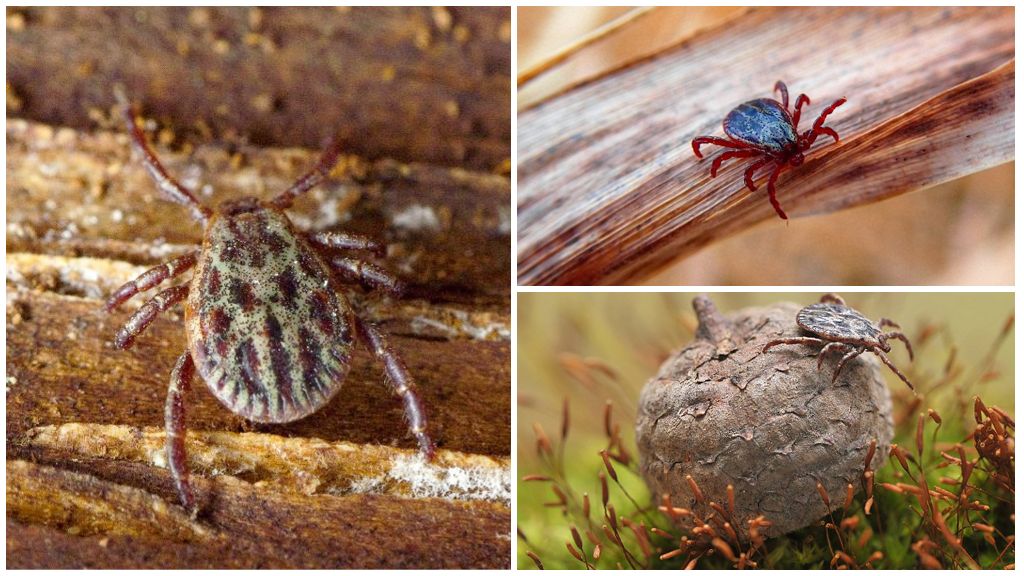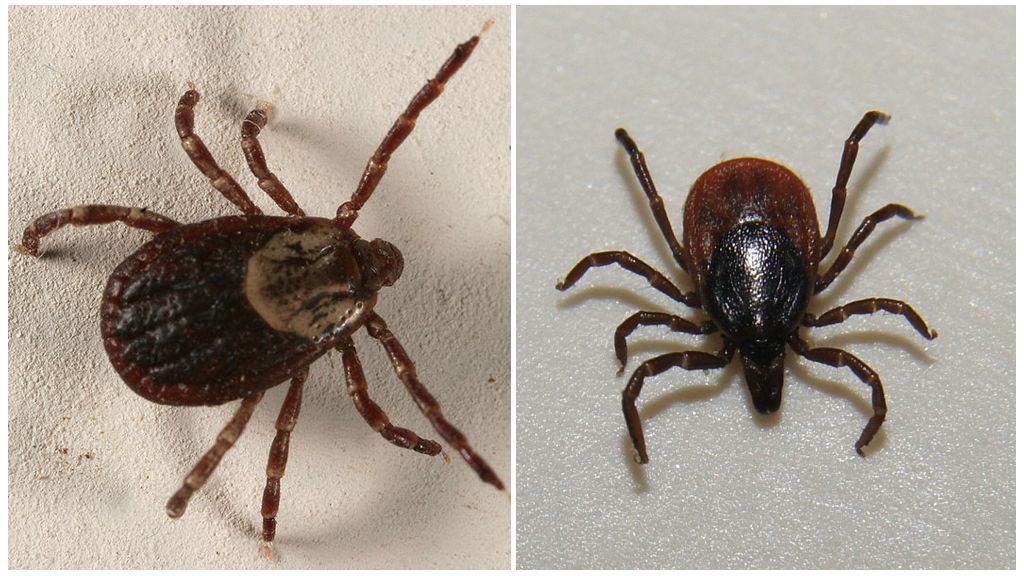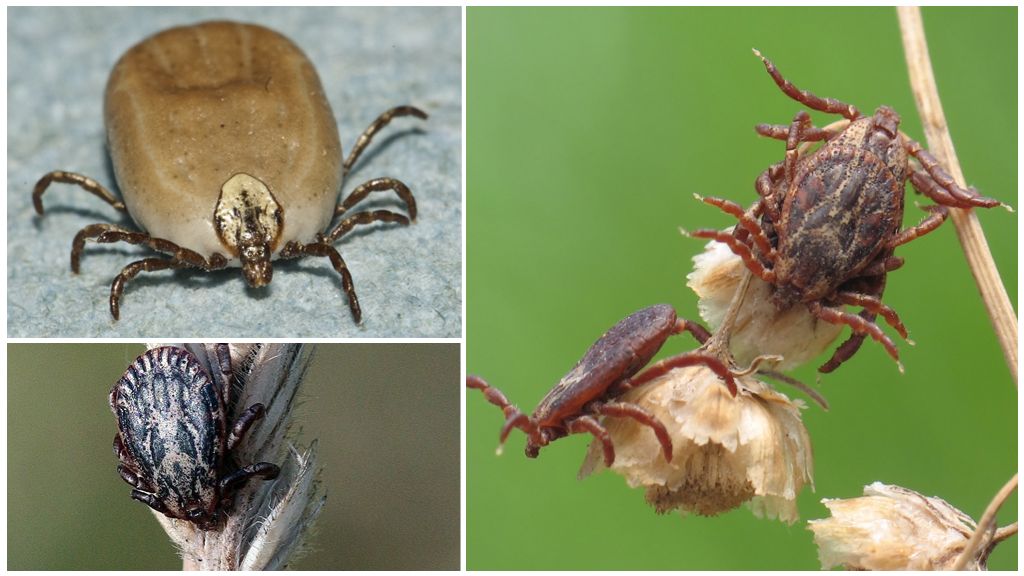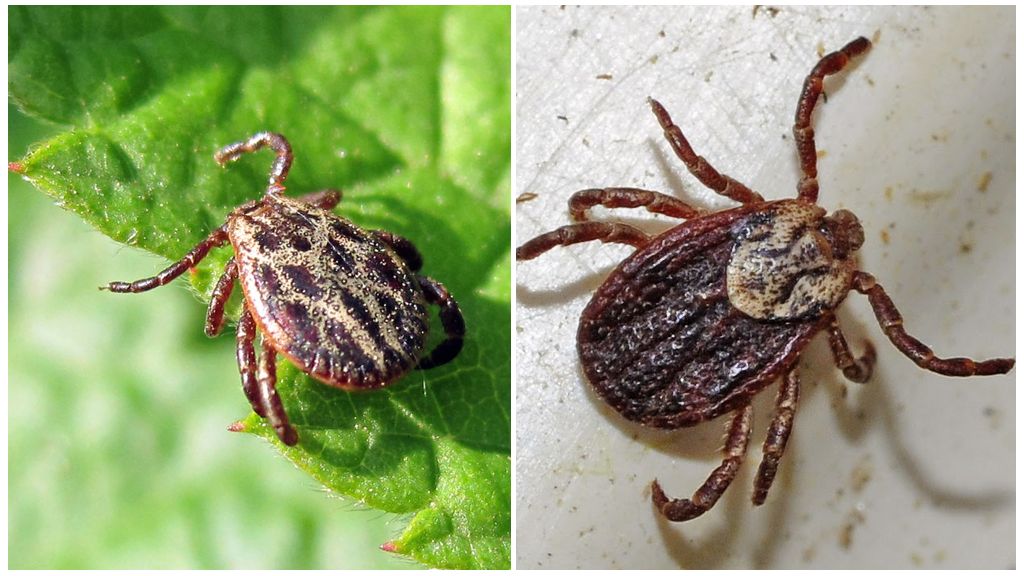- Parasitiform ticks
- Acariform ticks
- Ixodid ticks
- Types of ixodid ticks
- Argas Mites
- Sarctiform tick and saprophyte tick
Ticks are animals of the arachnid class. Today already found and described more than 54 thousand species of these arthropods. Of the total number, only 144 species have died out. The rest are still alive. This is the largest group of the arachnid class. “To conquer the world” small ticks helped sizes and a fairly wide food spectrum.
Classification principles
Tick species have different food addictions. Some feed on plant sap, others on rotting organics, third on blood, fourth on dead parts of the epidermis and coat. But there are no highly specialized species among them. If the juice is the juice of many plants. If blood, then from all warm-blooded organisms that live in the area. If organic, then it is still of plant or animal origin. The classification of ticks is multistage. These animals are divided into groups not only by lifestyle, but also by type of food and appearance.
On a note!
These arthropods are not insects, they are closer to animals such as spiders, crabs and crayfish.
What are the ticks
The classification of living organisms in biology is based on phylogenesis - the evolutionary origin and development of species. But debates about the phylogenesis of ticks among scientists do not subside and in the future the data may change.
On a note!
To date, the tick suborder is divided into two large groups: parasitiform and acariform.
The first group includes parasites, predators and saprophages (organic processors). In the second group, all of the above are also present, but these animals are capable of completing segments in the process of life.
Parasitiform ticks
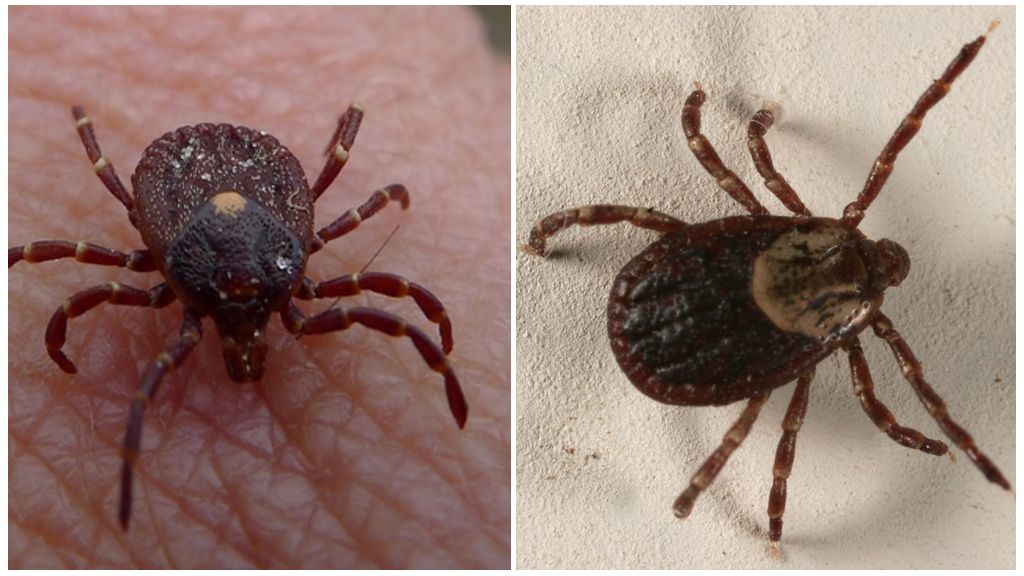
Parasitiformes superorder includes:
- Order Opilioacarida, which includes only one family of mowing mites. The family contains 25 modern species.
- Order Ixodida includes one superfamily of ixodoid ticks, which is divided into 3 families: ixodic, argas, Nuttalliellidae are endemic to Africa, having a single species in the family.
- Order Holothyrida contains 27 species, but all of them are found in the southern regions of the planet and feed on the hemolymph of dead arthropods.
- The order Mesostigmata is the most numerous in the order, includes more than 70 families containing a total of 8000 species of ticks. Representatives of this squad are predators.
On a note!
For a person, the order of ixodid and mesostigamate is of interest. The first because of the danger to life, the second are useful as assistants in the fight against agricultural pests.
Acariform ticks
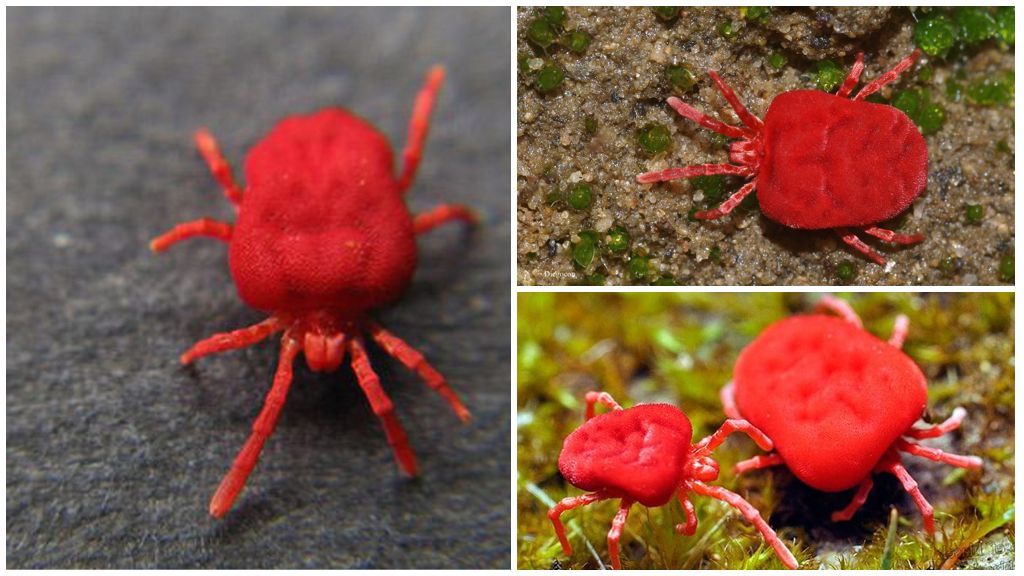
In this order of arachnids, there are more than 30 thousand species. The classification of acariform ticks is quite confusing and is carried out according to different methods. Of interest in this order are sarcoptoid mites that cause ear scabies.
What ticks look like: all representatives of this suborder have similar morphological characters by which they can be accurately identified. In detail, the description of the species of ticks varies: parasites have powerful tenacious paws that help to stay on the host.Their oral apparatus is different in structure from the oral apparatus of animals that feed on organic matter. But the general description is similar.
- The body is round or ovoid, flattened above and below. Usually the body is solid, but can be divided into 2 parts, the border between the cephalothorax and the abdomen passes closer to the front of the body.
- There are usually 4 simple eyes on the head, but some types of eyes can have 5 or less than 4, up to 1.
- Ticks usually have 12 appendages arranged in pairs. 4 back pairs - legs. The tips of the legs are equipped with claws and suction cups for better retention on the surface.
- Larvae are usually six-legged. Two front pairs are included in the oral system.
- The body of some species (dog tick and others) can be protected by a chitin shield. In other species (like the Persian tick), the body is soft.
- The length of hungry ticks is from 0.2 to 5 mm.
Parasite mites
Ticks attacking humans include ixodid and sarcoptoid ticks. Of the latter, people are most often infected with an itchy tick that causes scabies. The second parasite from this group is the ear tick, which feeds on the fat and subcutaneous lymph that is released in the ears. As a result of the activity of sarcoptoid ticks, a person experiences itching. Scabies mites so small that they can only be seen under a microscope. A large photo of the Otodectes cynotis tick below.
Short description and names of species of ticks
All 54 thousand can be described only by a guide to acarins, so you will have to confine yourself to the most common and living within the reach of the inhabitants of the Russian Federation.
Ixodic
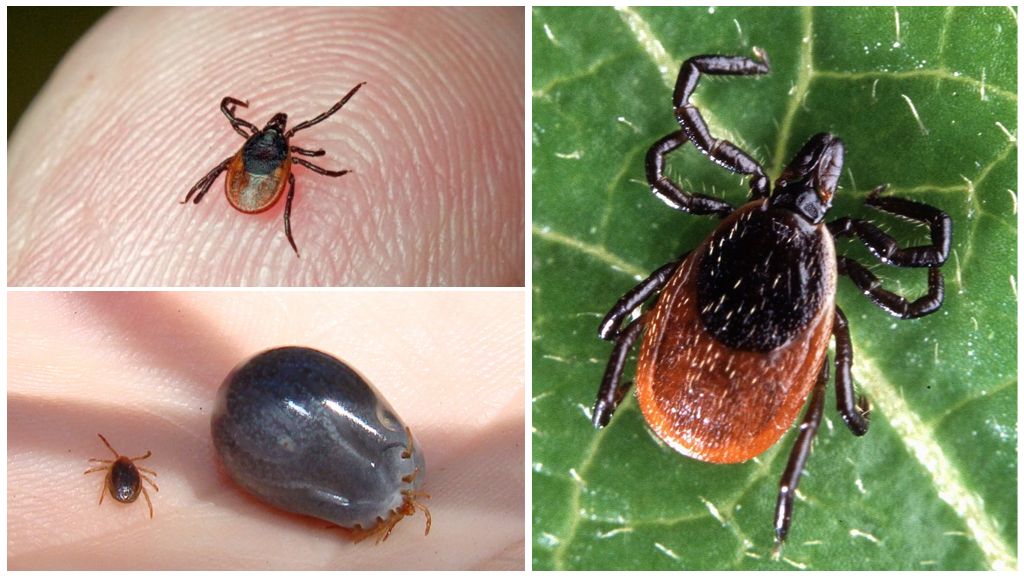
This group of ticks is widespread in Russia. The three most common species have received the collective name "forest" for their addiction to forest biotopes. All kinds forest ticks prefer deciduous and mixed forests. Of these, the most common:
These species are the main disease vectors on the Russian territory. The familiar dog tick is common throughout the Russian Federation. Main habitat - forest and meadow, but found even in cities "on the pavement." Parasites get there, "arriving" on animals. The drunk female falls away and lays eggs where it fell. She is not able to crawl away.
A tick with a pattern on the back - meadow (Dermacentor reticulatus). In the forests without undergrowth, he does not occur. This tick in the grass is waiting for the victim, because of which it is often called a grass tick. Prefers open spaces: edges, water meadows, pastures. It can tolerate flooding by melt water. Very cold resistant. Its activity begins earlier than that of taiga. The peak of activity falls on April-May. It ceases its activity only with the onset of cold weather.
His closest relatives of the same kind are found:
- grazing (Dermacentor marginatus) in the steppes and forest-steppes of Kazakhstan, the European part of the Russian Federation, Transcaucasia, Central Asia, in the south of Western Siberia;
- Dermacentor nuttali - Siberian forests;
- Dermacentor silvarum - forest-steppe of Eastern Siberia and the Far East.
All these species have a characteristic pattern on the back, which can be seen in the photo of the meadow tick below.

Taiga, in addition to the "honorary" title encephalitis, also called "wood tick". He does not sit in the trees, waiting for the victim, but few people wonder where this animal came from on the clothes. Many believe that it jumped from a tree branch. Moreover, this species prefers forests rather than open spaces.
Similar habits in the ixodic Haemaphysalis family. But ticks of this family prefer deciduous forests, where they wait for the victim, sitting on the grass. They live in Crimea, the Far East and Transcaucasia. They can be found in the south of Altai, Western Siberia and in Transbaikalia.
Important!
All ixodid ticks transmit the same diseases dangerous to humans, including encephalitis, borreliosis. Any species of ixodidae has the full right to be called encephalitis, since this family of ticks parasitizes on animals and humans. A tick infected by an animal transmits the disease to humans.
Ixods are similar not only in appearance but also in lifestyle. The sexually mature female tick only eats once, preferring large mammals. A drunk female falls away from the victim to complete breeding cycle. Ticks of the ixodidae family lay eggs up to 17 thousand. Units survive to puberty due to the large number natural enemies and difficulties finding a victim. The female does a laying on moist soil. The hatched larva finds a victim and, having drunk blood, falls away to turn into a nymph. The nymph's actions are exactly the same.
Natural enemies
Ixodians eat:
- birds;
- small reptiles;
- predatory insects;
- other predatory mites;
- ants.
The destruction of the habitat of these creatures leads to an increase in the number of ticks.
Argasovye

This family includes the largest representatives of the tick superorder. The size Argas Arthropods can be from 3 to 30 mm. The total number of species in the family is 200. 12 species can attack a person, causing a severe allergic reaction. Argas also tolerate 2 types of relapsing fever and tick-borne borreliosis. For humans are dangerous:
- Persian;
- Caucasian;
- township;
- conch.
Europe and Russia have been familiar with the last three for a long time. Persian is a new species of ticks imported from the Middle East. In endemic areas, he suffers a fever, which is very difficult for foreigners.
Externally and in behavior is very similar to bedbugbut larger. Body length up to 10 cm, width up to 5 mm. The main target of the attack is birds. It also attacks people and is able to jump on a person from the ceiling. Active at night.
On a note!
Tick mites are not built, but a female Persian tick lays 30-100 eggs in cracks on the walls. Such a masonry can be equated to a nest, especially during the mass reproduction of arthropods.
The appearance of a Persian tick can be seen in the photo below, so as not to confuse it with a bug.
Sarctiform ticks
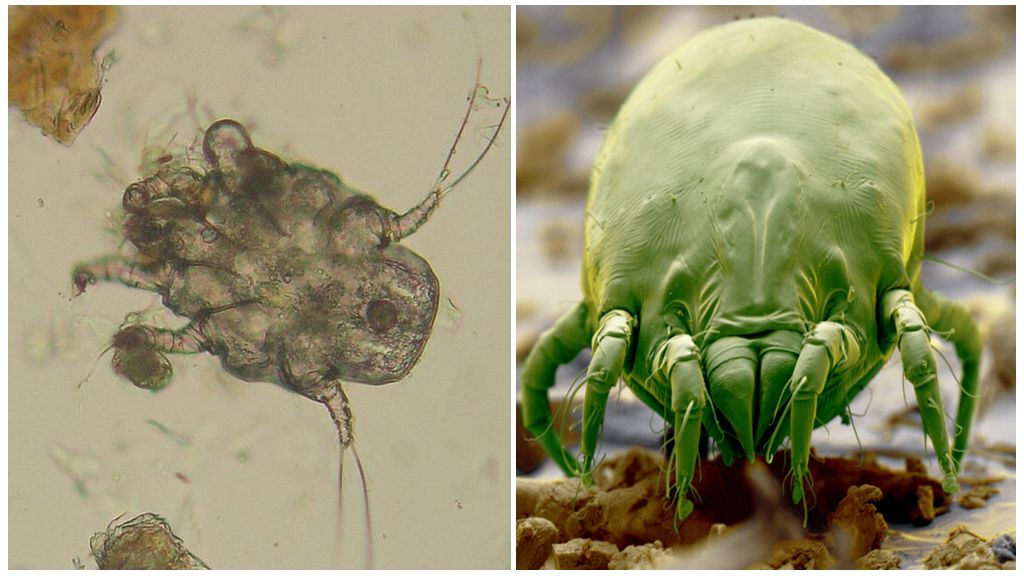
This order includes species that cause dog demodicosis, cats and scabies itch (Sarcoptes scabiei) affecting humans. Sarcoptiform ticks of animals and humans do not intersect. That is, you can not get scabies from a dog.
The external characteristics of the mites of the Sarcoptiformes order are so similar that there is debate in the scientific community whether to consider them as one species or several. But the nutritional objects of these small arthropods are different. A photo of a human tick causing scabies below.
But not all arthropods are equally harmful. There are also harmless and even necessary.
Saprophytes
These are arthropods that feed on decaying organics. Mite saprophytes are relatively harmless. Most of them process rotting organic matter, improving soil quality like earthworms. But the well-known "dust allergy" actually arises from the presence in the house dust mites Dermatophagoides farinae.
These are microscopic creatures measuring 0.1-0.5 mm. They feed on epidermal flakes, particles of fallen hair and animal hair, and waste products.
The "dust allergy" is actually caused not by house dust, but by the excrement of dust mites and particles of the shells of dead arthropods. Dermatophagoides farinae live in uncleaned dust in corners and under furniture, in sofas, pillows, mattresses. For rid of this species of arachnids conduct regular thorough cleaning and processing of upholstered furniture.
